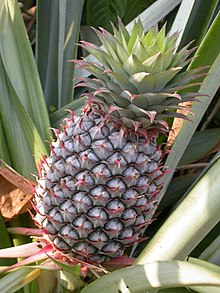
Back Bromeliaceae Afrikaans بروميلية Arabic بروميليه ARZ Bromeliaceae AST Bromeliyakimilər Azerbaijani آناناسیان AZB Брамеліевыя Byelorussian Бромелиеви Bulgarian Bromeliaceae BS Bromeliàcies Catalan
| Bromeliaceae Temporal range:
| |
|---|---|

| |
| Pineapple (Ananas comosus), a bromeliad of economic importance | |
| Scientific classification | |
| Kingdom: | Plantae |
| Clade: | Tracheophytes |
| Clade: | Angiosperms |
| Clade: | Monocots |
| Clade: | Commelinids |
| Order: | Poales |
| Family: | Bromeliaceae Juss.[1] |
| Subfamilies | |

| |
The Bromeliaceae (the bromeliads) are a family of monocot flowering plants of about 80 genera and 3700 known species,[2] native mainly to the tropical Americas, with several species found in the American subtropics and one in tropical west Africa, Pitcairnia feliciana.[3]
It is among the basal families within the Poales and is the only family within the order that has septal nectaries and inferior ovaries.[4] These inferior ovaries characterize the Bromelioideae, a subfamily of the Bromeliaceae.[5] The family includes both epiphytes, such as Spanish moss (Tillandsia usneoides), and terrestrial species, such as the pineapple (Ananas comosus). Many bromeliads are able to store water in a structure formed by their tightly overlapping leaf bases. However, the family is diverse enough to include the tank bromeliads, grey-leaved epiphyte Tillandsia species that gather water only from leaf structures called trichomes, and many desert-dwelling succulents.
The largest bromeliad is Puya raimondii, which reaches 3–4 metres (9.8–13.1 ft) tall in vegetative growth with a flower spike 9–10 metres (30–33 ft) tall,[6][7] and the smallest is Spanish moss.[citation needed]
- ^ Angiosperm Phylogeny Group (2009), "An update of the Angiosperm Phylogeny Group classification for the orders and families of flowering plants: APG III", Botanical Journal of the Linnean Society, 161 (2): 105–121, doi:10.1111/j.1095-8339.2009.00996.x, hdl:10654/18083
- ^ Gouda, E.J.; Butcher, D.; Gouda, C.S. (2022), "Species and Infra Species Counts", Encyclopaedia of Bromeliads, Utrecht University Botanic Gardens, retrieved 2022-11-24
- ^ Mabberley, D.J. (1997). The Plant Book. Cambridge: Cambridge University Press. ISBN 9780521414210.
- ^ Judd, Walter S. Plant systematics a phylogenetic approach. 3rd ed. Sunderland, MA: Sinauer Associates, Inc., 2007.
- ^ Sajo, M. G. (2004). "Floral anatomy of Bromeliaceae, with particular reference to the epigyny and septal nectaries in commelinid monocots". Plant Systematics and Evolution. 247 (3–4): 215–31. doi:10.1007/s00606-002-0143-0. S2CID 20457047.
- ^ "Llifle". Encyclopaedia of living things.
- ^ "Puya Raimondii - World's Largest Bromeliad". Strange Wonderful Things.